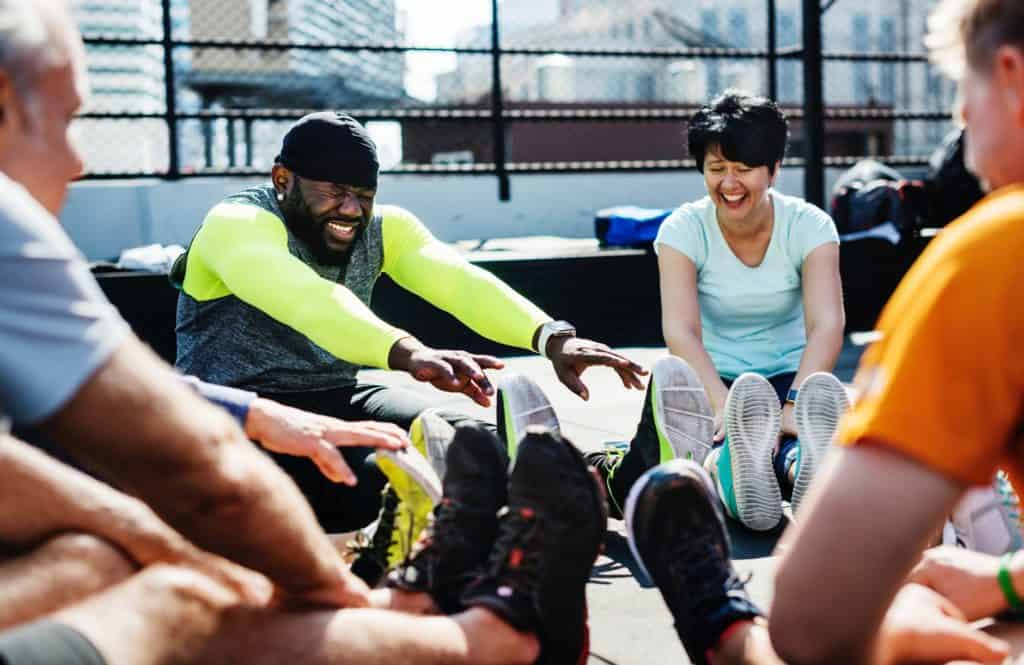Forge Your Own Fitness Path
Busting your butt to get in shape can seem like an uphill battle, complicated, and a quick route to being broke (literally or financially). Actually, it’s not even close. You don’t need a swanky gym pass, a shed load of gear, or countless hours each day just to kickstart your journey or create your own fitness program. These are all lies fed to you by a materialistic world that insists you need the slickest shoes or top-tier rower to get carved. That’s utter nonsense. A few miles of fair road or trails, a smack of grass or solid floor, time, effort, and your body— that’s all you really need to get in awesome physical shape.
Not sure how to get the ball rolling? Start with understanding the pillars of every effective training blueprint. This knowledge lets you tailor-make your own workout program. When you learn how these jigsaw pieces fit together, you’re in charge of your own fitness. And remember, I know that striving for personal excellence isn’t just about making gains in the gym—it’s about conquering life. Whether you’re raising a family, grinding at work, or just oozing confidence on the street, we’re on your team. So let’s rise above the nonsense, remember that fitness is a personal journey and start owning every single part of your life. You ready? Let’s dominate this.
Every Regimen Boils Down to the Basics
Whether you’re just getting your feet wet or an Olympian gearing up for your fourth rodeo, every fitness plan has the same ingredients at its heart:
- Goals
- Diet
- Hydration
- Exercise
- Recovery
Most people focus on bullet #4 and think that is all they need to do. Wrong.
These are all fundamentals. Avoiding any of them is a surefire path to a fitness disaster. These elements do work solo jobs if you want the best results—they’re a tight-knit squad, bolstering and each other and pushing you to elevate your game. Get the game plan down pat and people will notice.

Goals
Locking in a goal is a no-brainer first move in shaping any plan. Identifying your endgame and planting that flag commits you to progress. It’s less ‘admitting you have a problem’ and more ‘owning you have ambition’. See it as a challenge, not a chore.
Are you hitting the gym for wellness or to pack a punch in confidence? Interested in transforming your physique, flexing strength, mobility, and athleticism? Perhaps working up a sweat to boost your mood, blood flow, and sleep score? Nailing your top priorities guides you to comply with your regimen and knock those goals out of the park. So, what’ll it be?
- Shed weight
- Bulk up muscle
- Generic health boost
- Amplify the quality of life
No matter the aim, jot it down. Envisioning your destination clears the path for those stepping-stones on your journey. Stepping-stones can be minor victories like:
- Shed that initial 5 lbs
- Haul yourself to the gym three times a week for the next six weeks
- Treat yourself to dessert once a week, not as a daily indulgence
- Go for a 30 minute walk daily.
Your final destination might seem far off, but these bite-sized victories can fire up motivation rocketing you towards your ultimate goal, providing fresh targets to smash daily/weekly/monthly. Keep adding markers as part of your bespoke training curriculum. It’s your roadmap.
Bite-sized goals take the dull out of the routine and stoke motivation as you annihilate them. Motivation is the lifeblood of any workout plan. Without a robust ‘why’, it’s a slippery slope to Netflix over reps, and healthy habits crumbling. Your motivator is your secret sauce, delve deep, and decipher that ‘why’.
Struggling to build some motivation? Dive into some serious tips here.
Armed with a checklist of goals and markers, get down to business and strategize your action plan to snatch those victories. Remember, the pursuit of personal excellence isn’t confined within the gym walls. But it often begins there.
Diet
Your diet isn’t just a piece of the puzzle, it’s the freakin’ cornerstone of your fitness crusade. Without feeding your body the fuel it craves, your performance both in and out of the gym is destined to be underwhelming.
Know your BMR and TDEE; that’s how your body becomes a calorie-torching champion. Understand how many calories your body burns just being alive and how many it immolates during exercise. Gauge your intake versus output to see whether you’re in the range for shedding, stacking, or stalling.
When it comes to what you eat chow down on a diverse range of grub, but focus on unprocessed foods. Keep what you eat as close to nature as possible and keep an eye on serving sizes. The more processed it is, the less nutritional benefit it has, and chances are the more chemicals and other bad things it contains.
Grab a cup of raw broccoli, and you’re feasting on a nutrient jackpot for a mere 30 calories. Add in some hummus and you have a flavorful, healthy fat containing snack that is far more satiating than that bag of chips for roughly the same calorie cost. But an entire cup of almonds? That’s a hefty 530 calories and will blow your diet out of the water.
As a general rule:
Eating fewer calories = Dropping the pounds
Wolfing down excess calories = Packing on the weight
Eating roughly how many calories you burn = Staying where you are
Keep this in mind, though; diet is only one element of your master plan. It is the VIP of the bunch, and without its support crew, you won’t be crushing those fitness goals.
Get that diet in check if you want to make noticeable progress.
Hydration

Water is to your fitness game what oil is to a machine. Overlook its importance and you slam headlong to a full stop. Hydration is paramount to running your bodily functions like clockwork, from breaking down food to shuttling nutrients and ridding your body of toxins.
Not done yet. Hit the hydration sweet-spot and you’re boosting your immune system, greasing your joints, and keeping your skin shipshape.
And here’s the real zinger – hydration sharpens your mental edge. That’s a godsend when you need to focus in the gym instead of daydreaming about your weekend plans.
All massive wins. No rocket science here. Drink your water. Make sure it is included in your overall routine.
Need some help?
Shape Success, Live Exceptionally
Hit that button, and get started today.
Exercise
Recall my spiel about charting a plan? This is where things get real. Build a game plan before lacing up those trainers, so you’re not that clueless soul hogging the squat rack or the person wandering around clueless about what to do next.
Eyeing strength and might? Hoist the heavy metal
Hustling to drop belt sizes? Do that HIIT
Jotting down your blueprint gets you kicked into gear, nudging you ahead on schedule—a solid ground rule if you’re gunning for an improved you.
How Often Should You Exercise?
Kick-off your fitness journey on the right foot by hitting the gym 2-3 times a week. Consistency meets frequency here, and that’s a potent combo to drive rapid improvement. Trust me, when that stacks with good dieting and sound sleep cycles, you’re in for some swift transformations.
If you want visible results, fast, each week you’ll need to put in the effort.
Once you start nailing the milestones you’ve laid out, it’s time to up the game. From a modest 2-3 days, aim to break a sweat 5 days a week. Each micro-goal you smash not only gives a sense of achievement, but also fuels your motivation to strive harder. And let’s be honest, who doesn’t get a buzz out of seeing a sharper, fitter self smiling back in the mirror?
Maintaining a fitness routine amid bustling work environment or achieving a work-life-fitness balance while juggling parenting responsibilities is tough, which is why you should start where you can. If you can only hit 2-3 times per week at first, that is better than nothing.
Just make sure you build in recovery and time off.
Workout Structure
Nearly every workout has the same basic structure. Use it to create your own training regimen.
Warm-up (5-10 minutes):
A solid warm-up isn’t just another item on your checklist. It’s vitally important, especially as you age. Blowing off this crucial stage is like tossing your muscles and joints into the furnace without a heads-up. It’s almost a sure fire way to injure yourself.
Carve out 5-10 minutes for a warm-up.
Run a light jog, row it slow, whip up a jump rope, or toss in some dynamic stretching. Step it up with arm swings, walking lunges, and body-weight squats to wrap up your warm-up party.
In life, much like in fitness, a good warm-up sets the stage for peak performance.
Work-out
Your workout pattern must mirror what you’re hustling for. Eyeing better endurance? Conquer that treadmill, command the row machine, or rule the Zoomba beat. Chasing strength gains? Make a beeline for the weight floor and get on with lifting.
Resistance Training
Pinpoint a muscle group, or two. Could be your back, chest, abs, glutes, legs, arms —whatever gets you pumped. Sometimes, perform a cocktail of all on any given day.
Picking two muscle groups? Opt for rivals—one push group (pectorals, anyone?) against a pull group (back’s got your back, huh!). Load up with multiple exercises for each division and swing between them.
General guideline is that the heavier you are going, the fewer individual exercises you will need. German volume training has 100 reps of one exercise per muscle group with *maybe* 1-2 accessories, for example. Other workouts may have you choosing 5-6 exercises per muscle group if the intensity is lower.
Build out a plan that hits each body part at least once per week, but should aim for 2-3 times. Make sure you spread each time you target the same muscle group out about 48 hours. Putting two of the same workouts side by side often is counterproductive.
Cardio
Got a buffet of cardio options to choose from. Want to play long-distance runner? Blaze the treadmill like it owes you money or hit the pavement. More into the biker gang vibe? Test drive a cycling class. If you’re a HIIT kinda person or a Crossfit warrior, you’re sorted. Those classes are easy to find. Whatever your goal, just get it in.
Cardio should ALWAYS come after resistance training.
Cool-down (5-10 minutes):

You ever skip the cool-down? We’ve all been there but buddy, that’s bad news. Slice out the 5-10 minutes it takes post-workout to cool down. Bring down the heart rate, lower your core temp, stretch out those muscles, and you’re going to feel so much better in the morning.
Get in a round of passive stretching—hold those stretches for 30 seconds or beyond. Not only does it keep you loose, but it’ll reduce any stiffness that might inhibit you in your next workout.
Remember, you’re not just building a body here, you’re crafting a lifestyle. The cool-down isn’t just about reducing muscle stiffness; it’s about preparing your body for what comes next, inside and outside the gym.
Think of the cool down as a challenge. When you push yourself to do it even when you don’t think you need to, you don’t want to, or you feel you have no time for it, you are building a mentally tough person. Doing the hard things when you aren’t in the mood is the literal key to success in all you do.
Aerobic vs Anaerobic Exercise
When it comes to exercise, your body has two gears—Aerobic or Anaerobic—and you better know the difference. Both rev up your metabolism, but they tune your body in unique ways. Rule of thumb? A blend of both is non-negotiable for muscle-building, weight-shedding, and all-round awesome health.
Aerobic Training:
Easy does it. If you’re gabbing away mid-workout, you’ve landed in the Aerobic zone. Include jogging, rowing, swimming, and other similar non-explosive exercises in this range. Aerobic activity includes things that you can hold a conversation in while increasing endurance, cardiovascular fitness, and a revved-up metabolism.
Anaerobic Training:
Unlike aerobics, anaerobic exercise steals your breath, stirs your muscles and torches fat. It’s hard and maintaining it demands grit. The difference between Aerobic and Anaerobic? It’s all about how your body sources the energy. It’s a little bit too deep for this article, but if you can talk you are doing aerobics. If you can’t, you are working anaerobically.
Bottom line? Add in both for optimal results.
Blueprint for Building a Quality Training Plan: Decode the Trainer’s Mind
Hey, ever wonder how your trainer conjures up that amazing training plan? (Or maybe you never liked what they came up with so that is why you are here). Let’s break the code.
Step 1 – Assessment
Trainers kick off by studying YOU. They ask about your fitness levels, medical baggage, lifestyle chaos, and any goals you hold. It lets quality trainers grasp where YOU stand right now and build you a custom program based on your needs and goals.
Step 2 – Chunking the Plan
Next, your trainers split your plan into manageable chunks. Quality trainers will start off with a macro goal (long term goal), and then break that down into smaller training periods for sub goals. Those smaller periods are then built out into what we call ‘splits’, or the everyday workouts you do. Each period in the plan has an associated goal, with the long term aim being helping you hit your biggest goals.
Step 3 – Exercise Selection
This ain’t about picking the most savage exercises to unleash hell upon you. Instead, it’s about selecting exercises that fit that goal period. Exercises are chosen based on their ability to melt fat, spike power, or shape your muscles, tailored exactly for your goals and abilities IN THAT PERIOD. Once the exercises are chosen, they will be structured into sets and reps.
Step 4 – Progression
There’s more to it than just this. There’s a cunning strategy behind the whole thing. It’s about progressively overloading your body, nudging it to adapt, grow, and smash those goals. It’s not a quick sprint, it’s a marathon.
Here’s my no-nonsense advice. If you are building your own plan tailor it to your life, make it flexible, make sure it’s real. If it doesn’t fit, you won’t stick, simple as that.
In The End
You are probably wondering why I would give out the details on how to build your own plan while I also offer training myself. Well, the answer is because my goal is to never keep people as clients for life. I want to teach you how to do these things on your own so you can go out there and do it yourself.
Does that take money from my own pocket? Yes, but I would rather America fix it’s obesity, leadership, health, and lifestyle issues than capitalize on it. In the long run, I want the country better off. This is my contribution.
Of course, if you need some help when trying to create your own fitness program I will gladly be there for you.
Let Us Help You Out
I want to help you achieve better physical and mental health through exercise. Check out the plans I offer to my clients and see if you could benefit from working with me. If you have questions, you can always contact me through the Contact Us page.
Personal trainers, like myself, can help guide you on your pathway towards reaching your fitness goals, whether that is getting bigger, stronger, faster, more lean, or just generally feeling better.
If you choose to join one of my programs I’ll get you setup with a periodized workout plan, supplement information, and advice on nutrition to help you reach your goals. I also do advisory services that guide you along and answer questions you have if you don’t want a fully customized service.
The only thing you need is some motivation and a willingness to change some old habits.
Get into contact with me to find out what, if any, membership is right for you.

